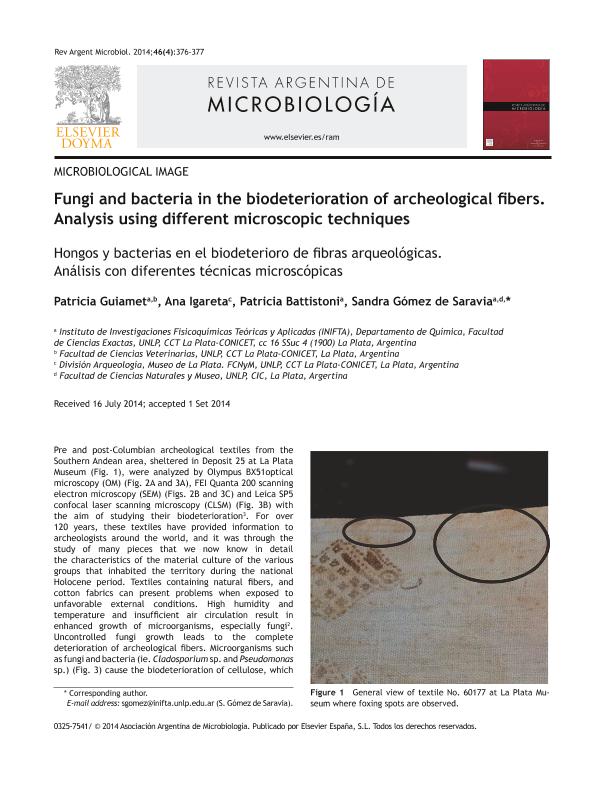Mostrar el registro sencillo del ítem
dc.contributor.author
Guiamet, Patricia Sandra

dc.contributor.author
Igareta, Ana Teresa

dc.contributor.author
Battistoni, Patricia Adriana

dc.contributor.author
Gómez de Saravia, Sandra Gabriela
dc.date.available
2016-04-12T17:42:11Z
dc.date.issued
2014-09
dc.identifier.citation
Guiamet, Patricia Sandra; Igareta, Ana Teresa; Battistoni, Patricia Adriana; Gómez de Saravia, Sandra Gabriela; Fungi and bacteria in biodeterioration of archaeological fibers. Analysis with different microscopic techniques; Asociación Argentina de Microbiología; Revista Argentina de Microbiología; 46; 4; 9-2014; 376-377
dc.identifier.issn
0325-7541
dc.identifier.uri
http://hdl.handle.net/11336/5156
dc.description.abstract
Pre and post-Columbian archeological textiles from the Southern Andean area, sheltered in Deposit 25 at La Plata Museum (Fig. 1), were analyzed by Olympus BX51optical microscopy (OM) (Fig. 2A and 3A), FEI Quanta 200 scanning electron microscopy (SEM) (Figs. 2B and 3C) and Leica SP5 confocal laser scanning microscopy (CLSM) (Fig. 3B) with the aim of studying their biodeterioration3. For over 120 years, these textiles have provided information to archeologists around the world, and it was through the study of many pieces that we now know in detail the characteristics of the material culture of the various groups that inhabited the territory during the national Holocene period. Textiles containing natural fibers, and cotton fabrics can present problems when exposed to unfavorable external conditions. High humidity and temperature and insufficient air circulation result in enhanced growth of microorganisms, especially fungi2. Uncontrolled fungi growth leads to the complete deterioration of archeological fibers. Microorganisms such as fungi and bacteria (ie. Cladosporium sp. and Pseudomonas sp.) (Fig. 3) cause the biodeterioration of cellulose, which is the main component of natural fibers such as flax and cotton4. This leads to loss of strength of the natural fibers, causing odor emission, esthetic damage, the presence of staining, discoloration (foxing) and finally loss of fiber structure5, and giving rise to significant losses at economic and cultural levels. Proper storage of textiles susceptible to biodeterioration in special containers under conditions of temperature and relative humidity suitable are effective preventive measures to avoid undesirable results. Essential oils and silver nanoparticles1, among others, can be used as disinfectants for the surface of archeological fibers, historical objects and archival documents. It is essential that all tasks and strategies used in the preservation of the material be written and documented photographically, so as to keep a record for regularly assessing changes of microorganism activity leading to textile damage.
dc.format
application/pdf
dc.language.iso
eng
dc.publisher
Asociación Argentina de Microbiología

dc.rights
info:eu-repo/semantics/openAccess
dc.rights.uri
https://creativecommons.org/licenses/by-nc-nd/2.5/ar/
dc.subject
Microbiological Images
dc.subject
Fungi
dc.subject
Bacteria
dc.subject
Biodeterioration
dc.subject
Archeological Fibers
dc.subject.classification
Compuestos

dc.subject.classification
Ingeniería de los Materiales

dc.subject.classification
INGENIERÍAS Y TECNOLOGÍAS

dc.subject.classification
Arqueología

dc.subject.classification
Historia y Arqueología

dc.subject.classification
HUMANIDADES

dc.title
Fungi and bacteria in biodeterioration of archaeological fibers. Analysis with different microscopic techniques
dc.title
Hongos y bacterias en el biodeterioro de fibras arqueológicas. Análisis con diferentes técnicas microscópicas
dc.type
info:eu-repo/semantics/article
dc.type
info:ar-repo/semantics/artículo
dc.type
info:eu-repo/semantics/publishedVersion
dc.date.updated
2016-05-06 15:52:43.262787-03
dc.identifier.eissn
1851-7617
dc.journal.volume
46
dc.journal.number
4
dc.journal.pagination
376-377
dc.journal.pais
Argentina

dc.journal.ciudad
Buenos Aires
dc.description.fil
Fil: Guiamet, Patricia Sandra. Consejo Nacional de Investigaciones Científicas y Técnicas. Centro Científico Tecnológico la Plata. Instituto de Investigaciones Fisicoquímicas Teóricas y Aplicadas; Argentina. Universidad Nacional de La Plata. Facultad de Ciencias Veterinarias; Argentina
dc.description.fil
Fil: Igareta, Ana Teresa. Universidad Nacional de La Plata. Facultad de Ciencias Naturales y Museo. División Arqueologia; Argentina
dc.description.fil
Fil: Battistoni, Patricia Adriana. Consejo Nacional de Investigaciones Científicas y Técnicas. Centro Científico Tecnológico la Plata. Instituto de Investigaciones Fisicoquímicas Teóricas y Aplicadas; Argentina. Universidad Nacional de La Plata; Argentina
dc.description.fil
Fil: Gómez de Saravia, Sandra Gabriela. Consejo Nacional de Investigaciones Científicas y Técnicas. Centro Científico Tecnológico la Plata. Instituto de Investigaciones Fisicoquímicas Teóricas y Aplicadas; Argentina. Universidad Nacional de la Plata. Facultad de Ciencias Naturales y Museo; Argentina
dc.journal.title
Revista Argentina de Microbiología

dc.relation.alternativeid
info:eu-repo/semantics/altIdentifier/url/http://www.elsevier.es/es-revista-revista-argentina-microbiologia-372-articulo-fungi-and-bacteria-in-the-90372025
dc.relation.alternativeid
info:eu-repo/semantics/altIdentifier/url/http://www.scielo.org.ar/scielo.php?script=sci_arttext&pid=S0325-75412014000500015&lng=en&tlng=en
dc.relation.alternativeid
info:eu-repo/semantics/altIdentifier/url/http://www.sciencedirect.com/science/article/pii/S0325754114700975
dc.relation.alternativeid
info:eu-repo/semantics/altIdentifier/doi/http://dx.doi.org/10.1016/S0325-7541(14)70097-5
dc.relation.alternativeid
info:eu-repo/semantics/altIdentifier/doi/10.1016/S0325-7541(14)70097-5
Archivos asociados
